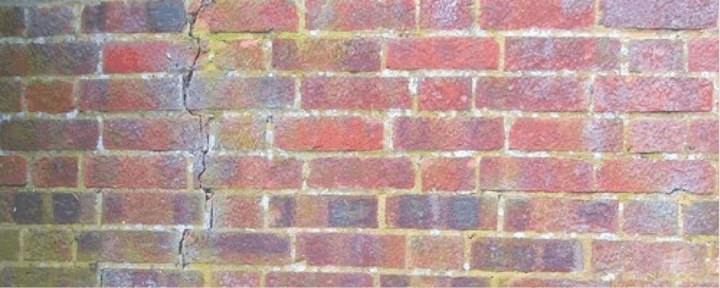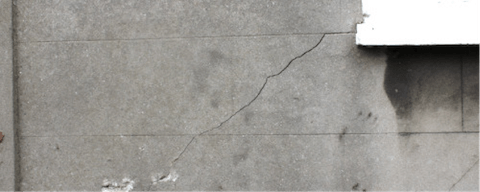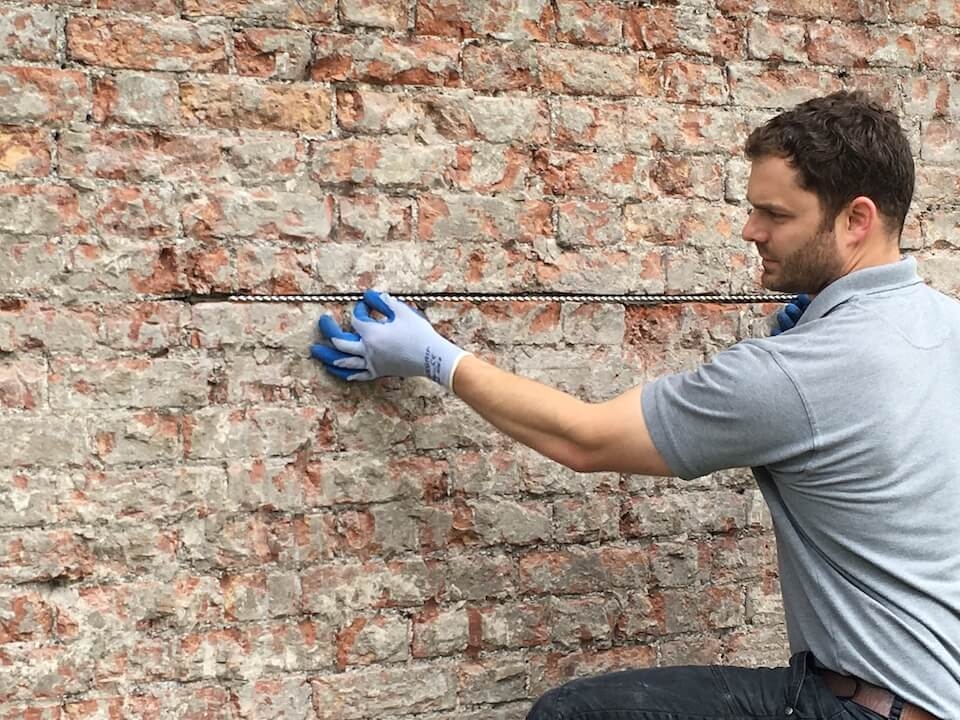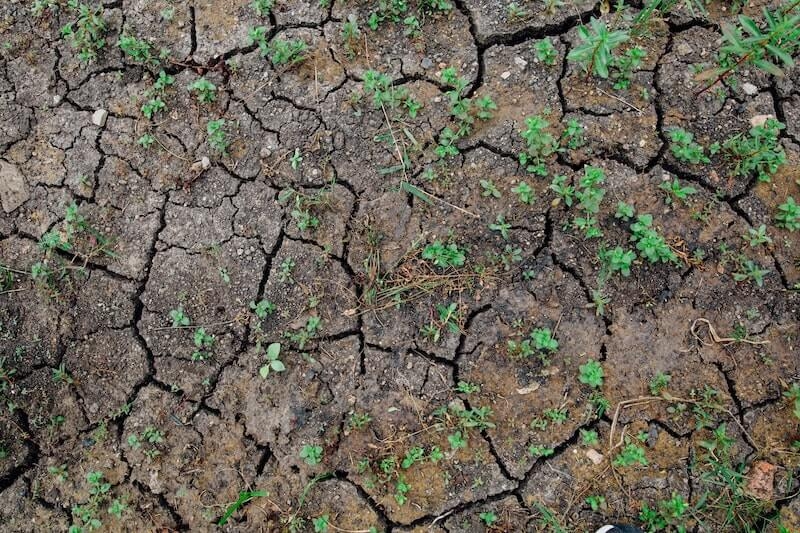How To Repair House Settlement Cracks In Florida
If you come across cracks in your external walls and so you lot may well be worried that the structural integrity of your dwelling house is at run a risk. There is no need to panic, however, as only a small amount of cracks are symptomatic of a more serious underlying structural trouble. The majority of the fourth dimension these cracks tin can be easily repaired. This guide provides information effectually determining the type of crack you have, what course of action to accept, in item how to repair your walls using cleft stitching.
What causes cracks in walls and what are the dissimilar types?
Cracks appear in a wall for a number of reasons:
-
House settling cracks
These tin occur as a new business firm 'settles' or when the construction materials expand and contract overtime with environmental changes.
-
Building motility cracks
They tin can as well exist caused when the foundations of the business firm motion. It is important to establish the root cause and and then to have professional communication earlier making a judgement as to what action to take.
-
Minor cracks
Some minor cracking occurs naturally and there is no need for business or activeness although information technology is always worth monitoring them closely for any change. In that location are other cracks that will demand some form of repair piece of work and others that will demand more than immediate and drastic attention.
Categorising Cracks in walls
The BRE (Building Research Establishment), who offer expert advice for the built environment sector, produced the BRE Digest 251 Assessment of Cracks in Houses. In this document, they identified six categories for cracks, which they describe along with the recommended fissure repair method. You tin can come across the categorisations below - italicised text indicates ease of repair:
| Damage Category | Clarification of Damage |
| 0 |
|
| ane |
|
| 2 |
|
| three |
|
| 4 |
|
| 5 |
|
Usefully, the BRE link the width and number of cracks to the appropriate type of repair. The first three types of fissure - 0, 1, two – only crave redecoration and no major work. Those cracks described in 3 and 4 require more major work but information technology is only the fifth type of crack that indicates astringent structural damage and needs urgent attention from a professional surveyor.
It is important to signal out that even with smaller cracks, you should monitor them over fourth dimension in case they increase in width. Whatever increment could be indicative of a more serious underlying issue. Those cracks that emerge over a brusque space of time, even pocket-size ones, are also potential causes of business organization when compared to those that have been at that place for years.
Consult a professional person structural engineer to confirm any diagnosis as well every bit an appropriate course of action.
Important Questions
If you consult a structural engineer or building professional they will want to know the following:
- How long have the cracks been at that place?
- Are they getting wider?
- Are they increasing in number?
Information technology is worth making notes as to when any new cracks announced and take measurements. A pencil line can be drawn across the cleft to monitor its movement.
Identifying Cracks in External Walls
There are ii main types of fissure that can appear in your masonry walls – vertical and stepped.
Vertical Cracks in External Walls
Vertical cracks usually occur in foundation walls when there is insufficient support below. The chief reason for this lack of support is when the soil beneath the foundation has not been properly compacted and compresses or fifty-fifty washes away.
The following is an example of a vertical scissure:

Stepped Cracks in walls
Stepped cracks unremarkably follow mortar joints and are nearly common about the corners of buildings. They unremarkably occur through wall movement related to foundation movement including subsidence.
The following is an example of a stepped crevice:

Horizontal Cracks in walls
Horizontal cracks in external walls are always a upshot of wall necktie corrosion. But don't worry - we have a complete guide that takes you through identifying and replacing corroded wall ties.
Why Are My Walls Croaky?
Cracks in walls can occur for a number of reasons. With new build houses, cracks tin can appear equally the business firm 'settles' (settlement of soil due to the weight of the building). In older properties small cracks can be adequately common as building materials shrink overtime. We have divided the main causes of cracked walls into structural and environmental factors:
Structural explanations:
- Subsidence – Subsidence is the downwards move/sinking of the ground that supports a building. These changes in ground atmospheric condition nether and effectually a building can crusade walls to move and cracks to announced. Subsidence is more common in areas with dirt soil (mainly in the South of England), which can compress in dry weather. Sandy and silty soils in the foundations can experience leaching when minerals get washed abroad. For more than on Subsidence, read this guide from the ABI.
- The shrinking, drying out and degradation of construction materials like timber, plaster, and physical.
- Structural failure – if an element of your business firm has been congenital incorrectly and subsequently fails then this tin cause cracks to appear in your home.
- Corrosion of wall ties.
- Failure or damage of timber lintels over windows and doors.
- Mining – in erstwhile coal mining areas subsidence can occur.
- Heave - refers to upward ground movement equally soil expands due to an increase in wet content. When older trees and shrubs are removed, the basis can neat up equally the moisture the tree had previously removed builds up.
Environmental explanations:
- Thermal expansion – this ordinarily affects long or alpine brick walls and the overall superstructure of the building. Cracks occur when the brick work is exposed to summertime rut and there is a lack of sufficient control joints or expansion joints.
- Leaks – over time leaks can cause water to get into the render and for walls to crack.
- Freezing – ice can bear upon the render.
- Decay of materials.
- Moisture and temperature changes – significant changes in temperature and moisture similar driving pelting.
- Vibration from heavy traffic.
Identifying Cracks in Internal Walls
Internal wall cracks are just as mutual as those institute on the exteriors of a house. Some tin exist harmless. You may too experience the following types of internal crack in your abode:
Internal Cracks in Plaster Walls
Cracks in plaster walls can occur if the plaster dried too rapidly, if information technology was mixed incorrectly or as part of environmental change (similar temperature/moisture) in your domicile over time. These types of cracks can be resolved with simple repairs.
If the cracks render, are more than 5mm wide and/or there are corresponding cracks on the external wall so it could suggest wall movement and structural issues. These will need to be investigated.
Cracks around Windows and Doors
If y'all accept cracks effectually a window or door, then these can be down to the failure of an old timber lintel or a shift in the foundations. Conversely, if the house has been recently built, the timber volition nevertheless be fairly fresh and may contain a high moisture content. Over time as this moisture evaporates, the timber elements will modify, perchance resulting in cracks around windows and doors.
Hairline cracks
Diagonal cracks beyond the upper parts of the wall (hairline cracks) are normally an indication of a business firm settling in. Erstwhile houses can shift and movement over time as temperatures fluctuate. This can issue in small cracks appearing as the edifice adjusts to these minor changes.
Subsidence cracks internal walls
Subsiding walls are usually the cause of more serious internal cracks. They occur when the ground supporting the foundations changes, resulting in an uneven force per unit area distribution across areas of the building. Internal subsidence cracks will usually occur effectually doorways, windows and any weak point.
How to Repair Cracks in Walls
There is an inexpensive and highly constructive way of repairing cracked walls called crack stitching. With a scissure stitching kit you can repair vertical and stepped cracks to protect the structure of your home. Yous will demand to follow instructions closely when repairing cracks in walls.
What is Crack Stitching?
Crack stitching is a permanent solution to cracks in masonry walls. It involves embedding stainless steel helical confined into horizontal slots into the mortar bed joints of your wall to restore structural integrity.
When do I need Crevice Stitching?
If you take identified and resolved the underlying issue that is causing the cracks in the wall to announced, you are then a position to repair the cracks in your walls. Fifty-fifty if you have smaller cracks, it is worth repairing them sooner rather than later equally water ingress from leaks or driving rain tin make the problem worse. Merely once the root cause of the cracks has been resolved y'all tin can progress with crack stitching.
How do I Apply Scissure Stitching
i. Cut a slot in the mortar bed just over 500mm either side of the vertical crevice and to the correct depth, dependent on the wall thickness (see the chart below).
| Wall Thickness | Depth of Slot | Depth of Bar |
| 102mm | 30mm | 20mm |
| 215mm | 40mm | 30mm |
two. Ensure the mortar is completely removed to reveal the top and bottom faces of the masonry. Remove all loose material (you tin can use a blow out pump) and then flush the articulation with water. Unremarkably vertical spacing is every 4 - 6 brick courses but check with a structural engineer if in doubt.
3. Mix the PermaCEM Ballast Grout thoroughly using the paddle mixer provided and load into the gun. Pump the grout to the back of the slot in a continuous fifty-fifty bead to approximately 2 thirds of the slot depth.
4. Push the helical bar firmly into the grout, making sure that the bar extends 500mm either side of the crack.
five. Apply a second bead of grout into the slot making sure that the bar is completely covered and with the trowel provided force the grout into the slot until information technology is approximately 10mm from the surface and ensuring that the bar and grout are firmly packed.
6. Stop by making skilful the bed joint and filling the vertical scissure with an appropriate filler to match.
Read our full How to Guide on Crack Stitching.

Tips
If two or more than cracks are shut together then confined tin can be lapped (overlapped) ensuring that the bar extends 500mm either side of the outer cracks and that the laps are at least 500mm.
Helical bars should exist aptitude and bonded at least 100mm around corners when cracks are within 500mm of the corner or a reveal etc. This system can be used for rendered or plastered walls.
Crack Stitching Products: What I Need to Repair Cracks in Walls
Permagard sell specialist crack stitching kits, which provide all you need to repair cracks in your wall. Our kits contain helical spiral confined, special grout, a mixing paddle, a mortar gun with nozzles equally well as a trowel. Permagard offer both a standard scissure-stitching kit and a heavy-duty kit for larger cracks.
Permacem Grout – grout the steel bars into place using Permacem Grout. This compress compensated grout with added polymer additives which sets effectually the helical bar and develops compressive force rapidly to prevent axial deflection of the helical bar under load conditions.
Products
i. Crack stitching kits
ii. Heavy duty Fissure Stitching
Permagard – Over 30 years' property maintenance experience
Permagard are proud of our technical squad who are bachelor to advise you on all aspects of crack stitching. Whether you are a specialist installer or want help with installation our technical advisors are here to help. Requite us a telephone call today on 0117 982 3282.
Further Reading
What are Helical Bars?
How to Guide: Crack Stitching
Source: https://www.permagard.co.uk/advice/how-to-repair-cracks-in-walls
Posted by: pettiesblecliked1962.blogspot.com



0 Response to "How To Repair House Settlement Cracks In Florida"
Post a Comment